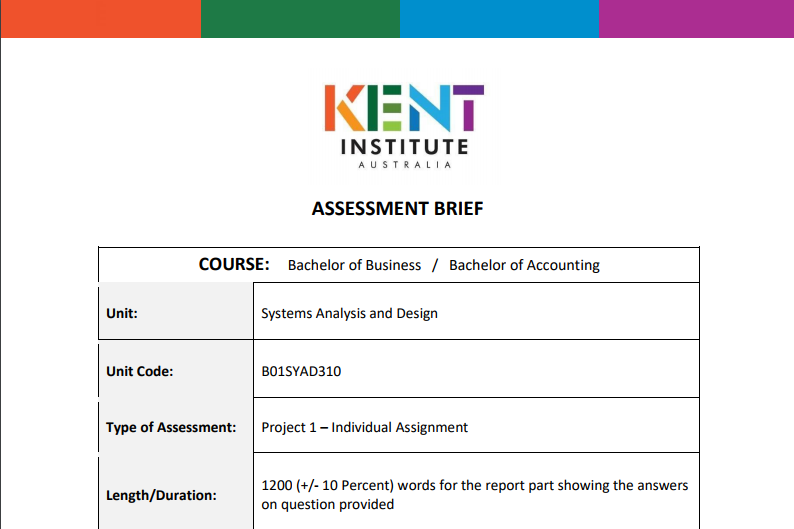Systems Analysis and Design
ASSESSMENT BRIEF –
COURSE: Bachelor of Business / Bachelor of Accounting
Unit Code: B01SYAD310
Type of Assessment: Project 1 – Individual Assignment
Length/Duration: 1200 (+/- 10 Percent) words for the report part showing the answers
on question provided
Course Learning Outcomes addressed:
• To demonstrate knowledge of broad business principles with
depth of understanding of at least one business discipline
• To develop effective oral and written communication skills
• To develop the skills to demonstrate a broad understanding of
business principles and demonstrate depth in at least one
discipline
• To develop the skills to allow the acquisition and synthesizing
of information within a complex professional setting
• To develop and apply skills in critical thinking, complex problem
solving and decision making
• To develop and apply knowledge of the social, economic,
ethical and cultural contexts of business
• To develop and apply an understanding of independent as
well as group learning.
Unit Learning Outcomes addressed:
• Demonstrate an understanding of systems analysis in business
environment
• Learn and apply project management, cost estimation and
change control techniques to Information Systems
development
• Analyse and model the business’ requirements of data and
processes
• Carry our data and systems design
• Learn and apply different system development methods to
design and develop business information systems
• Recognise importance of system support services for
maintenance, quality control and security of the systems
Submission Date: Written assignment submitted to Moodle in Week 9
Assessment Task:
This assignment requires you to demonstrate an ability to present a
sound argument showing reasonable decision-making and evaluative
skills based on the material learned and to demonstrate ability to
research and use credible references to aid the decision-making
process and the presentation of the argument.
Total Mark: 45 marks
Weighting: 45% of the unit total marks
Students are advised that any submissions past the due date without an approved extension
or without approved extenuating circumstances incurs a 5% penalty per calendar day,
calculated from the total mark
E.g. a task marked out of 40 will incur a 2 mark penalty per calendar day.
More information, please refer to (Documents > Student Policies and Forms > POLICY –
Assessment Policy & Procedures – Login Required)
ASSESSMENT DESCRIPTION:
This assignment requires you to demonstrate an ability to present a sound argument showing reasonable decision-making and evaluative skills based on the material learned and to demonstrate ability to research and use credible references to aid the decision-making process and the presentation of the argument. More specific details about the assignment description are provided as Project Description at the end of this document.
ASSESSMENT SUBMISSION:
See in Project Description at the end of this document.
MARKING GUIDE (RUBRIC):
See in Project Description at the end of this document.
GENERAL NOTES FOR ASSIGNMENTS
Assignments should usually incorporate a formal introduction, main points and conclusion, and will be fully referenced including a reference list.
The work must be fully referenced with in-text citations and a reference list at the end. We strongly recommend you to refer to the Academic Learning Skills materials available in the
Moodle. For details please click the link http://moodle.kent.edu.au/kentmoodle/course/view.php?id=5 and download the file “Harvard Referencing Workbook”. Appropriate academic writing and referencing are inevitable academic skills that you must develop and demonstrate.
We recommend a minimum of FIVE references, unless instructed differently by your lecturer.
Unless specifically instructed otherwise by your lecturer, any paper with less than FIVE references may be failed. Work that includes sources that are not properly referenced according to the
“Harvard Referencing Workbook” will be penalised.
Marks will be deducted for failure to adhere to the word count – as a general rule you may go over or under by 10% than the stated length.
GENERAL NOTES FOR REFERENCING
High quality work must be fully referenced with in-text citations and a reference list at the end. We recommend you work with your Academic Learning Support (ALS) site
(http://moodle.kent.edu.au/kentmoodle/course/view.php?id=5) available in Moodle to ensure that you reference correctly.
References are assessed for their quality. You should draw on quality academic sources, such as books, chapters from edited books, journals etc. Your textbook can be used as a reference, but not the lecturer notes. We want to see evidence that you are capable of conducting your own research. Also, in order to help markers determine students’ understanding of the work they cite, all in-text references (not just direct quotes) must include the specific page number/s if shown in the original. Before preparing your assignment or own contribution, please review this ‘YouTube’ video by clicking on the following link: Plagiarism: How to avoid it
PLAGIARISM: HOW TO AVOID IT
You can search for peer-reviewed journal articles, which you can find in the online journal
databases and which can be accessed from the library homepage. Wikipedia, online dictionaries and online encyclopaedias are acceptable as a starting point to gain knowledge about a topic, but should not be overused – these should constitute no more than 10% of your total list of references/sources. Additional information and literature can be used where these are produced by legitimate sources, such as government departments, research institutes such as the NHMRC, or international organisations such as the World Health Organisation (WHO). Legitimate organisations and government departments produce peer reviewed reports and articles and are therefore very useful and mostly very current. The content of the following link explains why it is not acceptable to use non peer reviewed websites: Why can’t I just Google? (thanks to La Trobe University for this video).
Project Information
Case Study
New Century Wellness Group (NCWG)
Capstone Case: New Century Wellness Group
New Century Wellness Group offers a holistic approach to healthcare with an emphasis on
preventive medicine as well as traditional medical care. In your role as an IT consultant, you will help New Century develop a new information system.
Background New Century’s information system must interface with 15 Australian health insurance providers.
The new system represents an opportunity for significant cost saving for New Century, and more convenience for patients, who will be able to go online to update medical information, schedule appointments, and request medical records.
During your fact-finding, you learned that the clinic requires various reports, as follows:
• Daily appointment list for each provider. The list shows all scheduled appointment
times, patient names, and services to be performed, including the procedure code and
description.
• Daily report call list, which shows the patients who are to be reminded of their next day’s
appointments. The call list includes the patient name, telephone number, appointment time, and provider name.
• Weekly provider report that lists each of the providers and the weekly charges generated, plus a month-to-date (MTD) and a year-to-date (YTD) summary as well as profit distribution data for the partners.
• Monthly patient statement, which includes the statement date, head of household name
and address, previous month’s balance, total household charges MTD, total payments
MTD, and the current balance. The bottom section of the statement shows activity for the
month in date order. For each service performed, a line shows the patient’s name, the service date, the procedure code and description, and the charge. The statement also shows the date and amount of all payments and insurance claims. When an insurance payment is received, the source and amount are noted on the form. If the claim is denied or only partially paid, a code is used to explain the reason. A running balance appears at the far right of each activity line.
• Weekly Insurance Company Report.
• Monthly Claim Status Summary.
In addition to these reports, the office staff would like automated e-mail and text messaging capability for sending reminders to patients when it is time to schedule an appointment. Data also needs to be maintained on employers who participate in employee wellness programs. This information can be used for marketing purposes throughout the year. Finally, the new system needs to track employee schedules, attendance, vacation time, and paid time off.
Now you are ready to organize the facts and prepare a system requirements document that
represents a logical model of the proposed system. Your tools will include DFDs, a data
dictionary, and create initial ERD for new system.
Tasks
Write report on following question (15 marks)
1. What types of system requirements will you focus on for NCWG? Explain each one in detail.
2. What fact-finding methods could you use to collect information from employees at NCWG?
Suggest at least three methods, and explain the pros and cons of each
3. Based on what you know about New Century, conduct a feasibility study that includes
operational, technical, economic, and schedule feasibility. Describe the results in detail, and explain how you reached your conclusions.
Modelling Exercise (20 Marks)
1. Prepare a context diagram for New Century’s information system.
2. Prepare a diagram 0 DFD for New Century. Be sure to show numbered processes for handling appointment processing, payment and insurance processing, report processing, and records maintenance.
3. Prepare a list of data stores and data flows needed for the system. Under each data store, list the data elements required.
4. Create an initial ERD for the new system that contains at least five entities.
5. Analyse each relationship to determine if it is 1:1, 1:M, or M:N.
Get ICT700 System Analysis and Design Assignment Help By Professionals.


